The Fantasy Genre has long been dominated by the religions and customs of countries touched on by the Crusades. While this makes sense, with the familiar image of a knight wandering foreign lands being key to the genre itself, there has been stagnation in recent times. As such, I’ve taken it upon myself to look into the cultures of the world and find fascinating details about other mythologies often overlooked by the genre we so love, going on a bit of a tour of world mythologies.
As we wind down through the cultures of the West African region, a lot of similarities show themselves not only to the other cultures in the region but cultures abroad. There are some which have clear parallels to Abrahamic religions with a singular god who sees over many smaller aspects that carry out their will. Others have a similar philosophy to the religions found in South and East Asia. But what becomes clear is that, while all of the details are very different, the human race and what we want to believe about our world isn’t all that different. After all, almost all of these monotheistic religions have one god who, more often than not, just wants the best for us.
Except Abassi, he’s a bit of a dick.
So it comes as no surprise that the Igbo, despite being such polar opposites to the neighboring Efik, aren’t entirely alone in some of their beliefs in their region. Their belief in finding spiritual enlightenment and successfully becoming one with their environment (a very Buddhist mentality) is also shared by another group of people in the Nigerian region. So, while one neighbor may not be too keen on peace and harmony, another neighbor shares a lot in common with them…
The Yoruba
The Yoruba people of southwest Nigeria are a people who reflect what we in the west would consider far-eastern traditions more so than any of the other cultures I’ve found so far. While their nearby neighbors, the Igbo, have similar concepts of peace, harmony, and spiritual enlightenment, the Yoruba go so far as to reflect concepts such as reincarnation, a loose similarity to karma, and being at harmony with the universe as a whole.
The Yoruba believe that all people have an “Ayanmo”, a destiny which bears some similarity to the “Chi” of the Igbo faith. A person is meant to achieve this destiny and become one with Olodumare, the divine creator and source of all things. However, they are not to achieve this in a single lifetime, instead going through a series of reincarnations throughout time as a cycle of life and death sends their soul from one lifetime to another as they continually seek enlightenment. If this sounds familiar, realize that the Yoruba lived 16,000~17,000 kilometers from the part of Asia where these beliefs were common as well.
In other words, this belief is one that happens to be engrained on the human psyche. It’s part of us, like ideas of the end times. But that doesn’t necessarily mean it’s all the same. Because there are aspects of the Yoruba religion all to their own. So to give you a taste of some of the differences, I feel like the best place to start would be at the literal beginning.
Creation
In the beginning of the universe there was Olodumare, both the creator god and a state of existence all should strive to reach. Olodumare is all-encompassing, one with everything and without form or gender. They were responsible for the creation of the universe and all within it and they are, in turn, also responsible for breathing life into the things that exist in our universe.
That’s not to say that the Earth was originally intended for life. There were many worlds in the cosmos that Olodumare created and of these there were many which could be appropriate for life. But the Earth was deemed to be too wet, covered in nothing but an endless ocean. This didn’t completely bother Olodumare though, as they were pleased with what they had created so far.
However, like other gods in the West Africa region, Olodumare creates spirits which acts as extensions of its will, called Orisha. The Orisha are entities that reflect manifestations of Olodumare and can be something like a spirit of nature or even a hero of the mortal realm granted power from beyond. But as it was creating the universe and bringing life to it, one Orisha in particular was called on to create land for people to live on: Obatala.
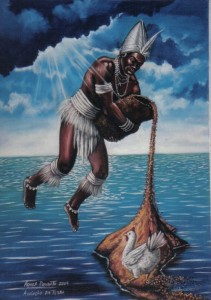
In fact, it was Obatala’s idea (as a manifestation of Olodumare) to create life in the first place. He felt as though the world as it was lacked energy and vitality, and believed it would be more interesting if things lived on it. The waters, though capable of supporting life, also lacked any of their own, though the Orisha of the oceans, Olokun, was okay with it staying that way.
Obatala, arguing for the creation of land and life to live on it, was granted permission from Olodumare to do it if he could show how it could be done. Given the chance to make it happen, he descended from the heavens to the world of water with a few materials in hand. The things he would use to create the land vary from story to story, but the most common variations seem to involve some iron, some dirt, a snail shell, a cat, and a chicken.
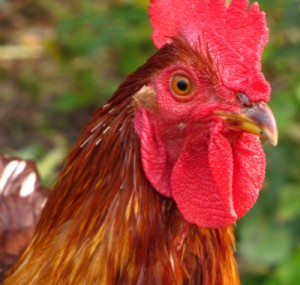
His plan wasn’t without some problems, however. The Orisha lived in the heavens, high above the waters. To get down he needed to craft a chain that could be used to climb down. He went to the goldsmith and asked them to create one long enough to lower him to the waters. The goldsmith agreed, but didn’t have enough gold to create a chain that long. Obatala understood and went to the rest of the Orisha for the gold he would need, bringing all he could back to the goldsmith. Unfortunately, it wasn’t enough.
Still, having enough to create a chain half way to the waters, Obatala decided that had to be enough. Taking the soil and putting it into the shell, Obatala used the chain to climb down with his materials. From his lofty position high over the waters he then dropped the iron to form the base, then poured the soil onto that base to create a mound. The chicken was then dropped to the mount to spread the soil around and scratch out the hills and valleys. And, once the mountains had grown high enough, Obatala was able to jump down.
As for what the cat was for?
It was literally there to keep him company on the surface. Obatala started life on the new ground, but didn’t really have much to keep him company at first. So, for a long time, it was Obatala, the cat, and not much else. It only some time later that Obatala came to decide he needed more than a cat and used the earth around him to create a new form that had never existed before. With the help of Olodumare to breathe life into these new forms, the two created mankind, beginning the cycle of life and death.
Reincarnation
The Yoruba believe that the soul, or Ori, is composed of separate parts which carry out different tasks. The chief task of their divine self is to complete their goals, master their fate, and become one with Olodumare by achieving transcendence. This isn’t a task one achieves in a single lifetime, however, so throughout time the soul undergoes a cycle of life and death where they constantly return to continue their spiritual journey in the physical realm.
This reincarnation comes with a few caveats, however. First, the soul will only reincarnate a portion of itself, a component sent to the physical domain as the rest remains behind in their version of heaven, Ikole Orun. This part will become a protective Ori of a new life, implanting itself into the crown of a newborn’s head and becoming a wellspring of wisdom and knowledge obtained from all previous lifetimes.
The new life in particular is not entirely “new” to the spirit as the Ori return only to members of their own bloodline. This has brought about terms such as Babatunde (father returns), Yetunde (mother returns), and Sotunde (the wise man returns). It is believed that the souls of the ancestors will return to their descendents, though when or where is unknown until it happens. All the while, the spiritual Ori, which remains on the spiritual realm, continues to follow it’s divine path to achieve its destiny. These two halves will eventually reunite at each new death and merge into one again, joining new life experiences with the old and continuing to follow the Ayanmo.
In essence, the Ori use the physical world to grind experience, much in the same way an RPG character would. And as they go on from one life to the next they will find themselves more equipped to deal with spiritual hardships. This reflects the common idea of an “old soul” who is less troubled with trivial things due to past life experience. However, this experience is not always beneficial. If a spirit stops growing in any of their given lives they will be destined for the “Orun-Apadi”, an invisible realm for the fragments of one’s spirit.

To ensure that these souls are properly prepared, Olodumare sends Orisha specifically tasked to put each person through trials in their lives and prepare them to deal with evils.
Eshu-Eleggua
Eshu is the Orisha of chance, the unpredictable nature of life. As the Orisha of chance he is responsible for all of the things you would consider lucky or unlucky. And because of this he is known to set traps and spur on malicious forces against you throughout your life. It is not that he is particularly evil, but rather a trickster with a task of showing your soul the way the world works.
The Yoruba believe that you can’t understand good unless you’ve experienced evil. The idea being that each new trial you undergo will show you the consequences of darker actions and will make you a better person as a result. As the Orisha of chance, Eshu’s chief task is to put you through as many trials as possible to push you further along your path. To do this, Eshu has 201 paths of his own, different aspects which will test you in a different way. Each of these paths has their own name, such as Eshu Adawa, Eshu Baradage, and Eshu Jano.
Eshu is not a malevolent force as a trickster, but his actions are always negative in nature. His job is to test you, not reward you for your successes, and he will continue to push without end. This essentially makes him the drill instructor of your soul, putting them through hardships so that they will be prepared for more that may come without Eshu’s interference. However, he is often paired with Eleggua, another spirit responsible for the good in one’s life.
Eleggua is the carrot, Eshu is the stick.
Eleggua is an Osha, one of the first Orisha warriors in the cosmos and a protective divinity which leads the way down the path of destiny one must travel. Consecrating Eleggua is the first task to be done by any following the path, as Eleggua controls the paths in question and is the first protection you have on the road to transcendence. He opens the doors and roads ahead of you and is often said to be behind any door you would open. Through Eleggua you can speak to other Orisha, as he opens the door to the other world. He cannot be circumvented as he is a fierce warrior and unstoppable when a task is before him, represented by the rocks in the world which cannot be moved or defeated.
These two work in unison (and are sometimes even considered two sides of the same entity), a representation of a constant bond between positive and negative. Eshu will put you through crisis in your life, but Eleggua will give you the ability to cope with whatever crisis may come. When the house is in disorder, it is the work of Eshu. When all is good within your family, it is the work of Eleggua. If your soul is balanced and staying true to the path, you will be under Eleggua’s protection. However, if you’re spiritually lacking, Eshu’s trials will push you further towards the realm of broken souls. Because of this, the two of them together are known as…
“The god of the crossroads.”
(I write novels, this blog, and sometimes witty tweets. Give them all a look, it’s better than sitting around with your cat and a chicken.)


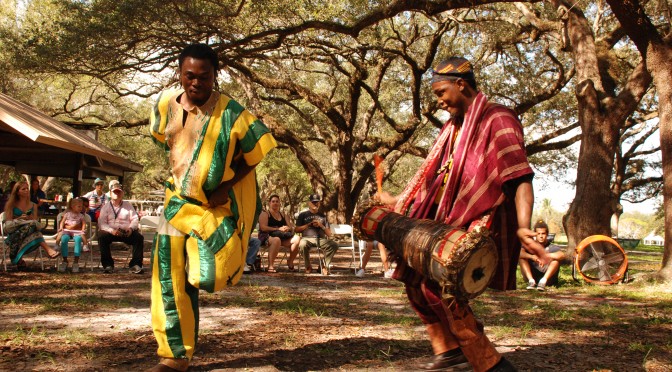
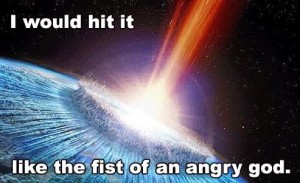
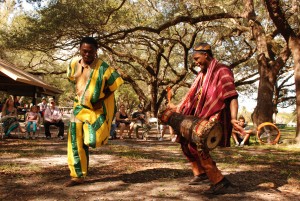
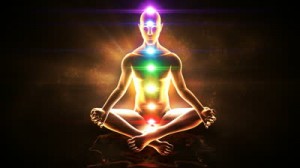
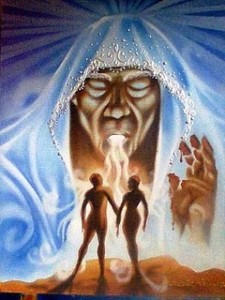
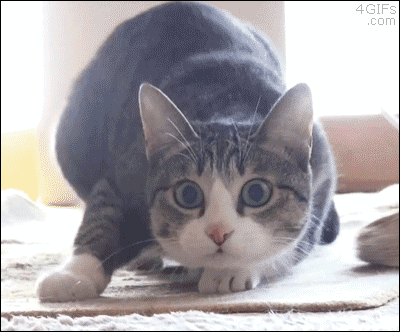
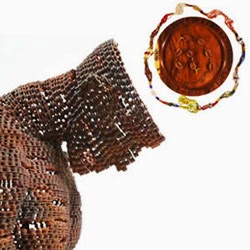

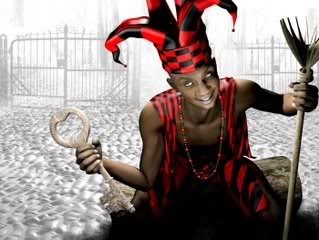
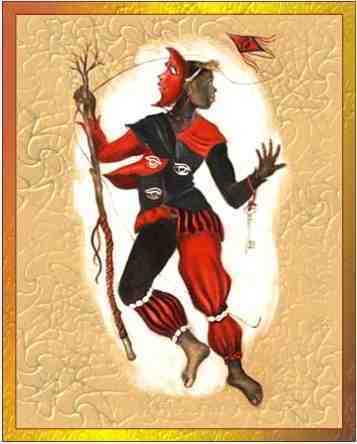
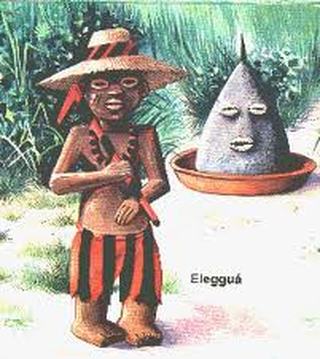





Hi! I was wondering if you know of the original source for the image of Obatala (the fifth one in the post)?
Thanks.
Unfortunately, by the time I found it there were copies all over the internet for roughly the same reason I’m using it. I’d love to be able to credit the original artist here, and you can see they signed the painting in the bottom left hand corner, but I’ve never found a bigger resolution so you could actually read it. I think the last name is “Desanto” and it seems to have been made in 2004 or 2009, but the first name has always escaped me. If anyone does know the original artist, I’d like to know myself.
Edit: It was bothering me again so I went looking and I believe that I’ve found it in a posting from the Federal University of Minas Gerais. It’s “A criação da Terra” by Agnes Dosanto from 2004 out of Brazil. Now that I know I think I’m going to update 🙂